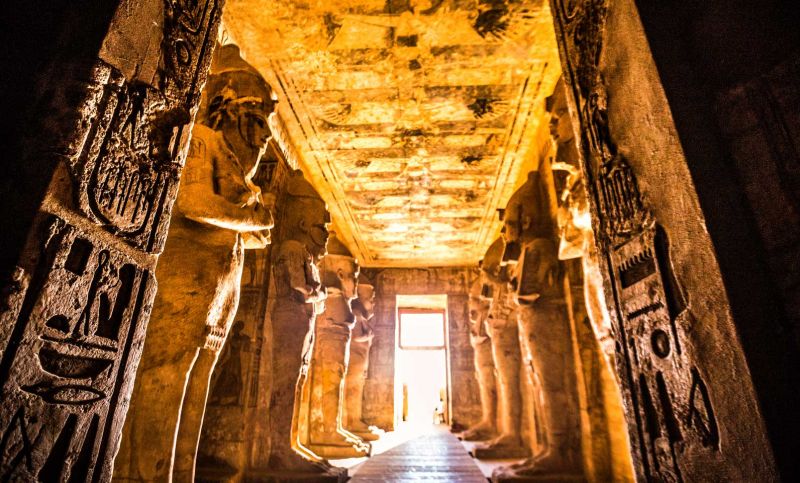The Temple of Abu Simbel is one of the most popular tourist attractions in Aswan, Egypt. It’s also one of the most impressive feats of ancient engineering. The temple was built by Pharaoh Ramses II in the 13th century BC to commemorate his victory at the Battle of Kadesh. It consists of two massive rock-cut temples that were carved into a mountainside, it’s the main destination to try in your Aswan excursions. The larger temple is dedicated to Ramses II, and the smaller one is dedicated to his queen, Nefertari. The temples were relocated in the 1960s to avoid being submerged by the Nile River during the construction of the Aswan High Dam, we recommend enjoying Egypt Nile cruises to sail and stop at the temple, it’s a tour that is worth trying. Today, they remain a popular tourist destination and a testament to the skill of ancient Egyptian architects and engineers.
The History of Abu Simbel Temple
Abu Simbel Temple is a temple complex located in the Nubian region of southern Egypt. The temple was built by the ancient Egyptian king Ramses II in the 13th century BCE. It is one of the most famous and best-preserved temples in Egypt tours from the Egyptian New Kingdom period. The temple complex consists of two massive rock-cut temples dedicated to Ramses II and his queen, Nefertari. The temples were carved into a mountainside and decorated with large statues of Ramses II and various gods and goddesses. It’s a must-visit attraction in Egypt travel packages in February and November as the sun is perpendicular to the statue of Ramses to celebrate his birthday and the day of his coronation.
The Abu Simbel temple complex was originally built farther away from the Nile River. However, due to rising water levels from the Aswan Dam, the temple complex was relocated in 1968 CE. The relocation of Abu Simbel was a massive engineering feat that involved moving the entire temple complex 64 meters (210 feet) up and 180 meters (590 feet) back from its original location. Today, Abu Simbel Temple is a popular tourist destination, and it is one of Egypt luxury tours‘ most iconic monuments.
The Architecture of Abu Simbel Temple
Abu Simbel Temple was built by Ramses II between 1264 and 1244 BC and is located in Nubia, southern Egypt. It is dedicated to the sun god Ra-Horakhty, Amun, and Ptah. The temple is considered to be one of the most impressive monuments of ancient Egypt and the highly demanded in the Egypt classic packages.
The temple complex consists of two temples: the Great Temple of Ramses II and the Small Temple of Nefertari. The Great Temple has four colossal statues of Ramses II, each 20 meters high. The front of the temple is decorated with a relief depicting the pharaoh’s victory at the Battle of Kadesh. The Small Temple is dedicated to Ramses II’s wife Nefertari and goddess Hathor. Join our day tour to Abu Simbel temple from Aswan to see the huge statues and impress your eyes.
The temples were carved out of a sandstone cliff on the west bank of the Nile River. They were designed to be visible from across the river and serve as a symbol of Ramses II’s power and greatness.
The Significance of Abu Simbel Temple
The Abu Simbel temples are two massive rock-cut temples in southern Egypt. They are located on the west bank of the Nile River, about 290 km south of Aswan, if your vacation limits you, add it just in your Egypt day tours to see this masterpiece in one day. The complex is part of the UNESCO World Heritage Site known as the Nubian Monuments, which includes six other sites along the Nile in Sudan.
The two temples were created during the reign of Pharaoh Ramses II in the 13th century BC, to commemorate his victory at the Battle of Kadesh. They were carved out of a sandstone cliff, and their facades were adorned with large statues of Ramses II and other members of the royal family. The larger temple was dedicated to Ramses II, while the smaller one was built for his queen, Nefertari. Our expert tour guide will join your family in Egypt family tours to share new and interesting historical stories together.
Despite their age, the temples have been well-preserved due to their location in a remote desert region. In recent years, they have become a popular tourist destination in Egypt study tours, and their significance has been recognized by UNESCO as “an outstanding example of early monumental architecture and land use.”
The Abu Simbel Temple in Aswan is one of the most incredible archaeological sites in Egypt spiritual tours. It is a must-see for anyone interested in ancient history or Egyptian culture. The temple was built over 3,000 years ago and has been remarkably well-preserved. It is an awe-inspiring sight and a fascinating place to learn about ancient Egyptian religion and architecture.




Comment (0)